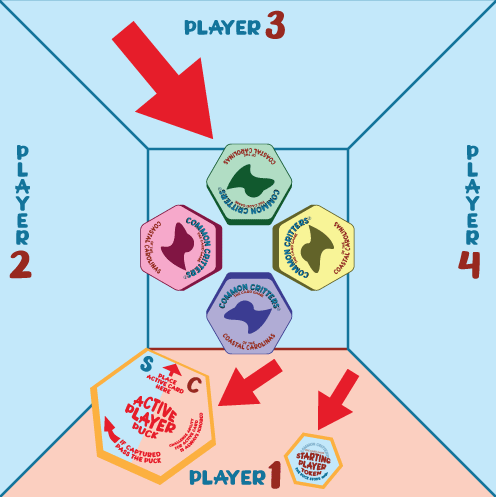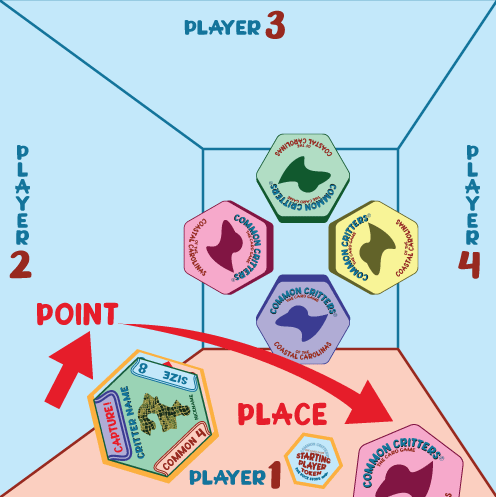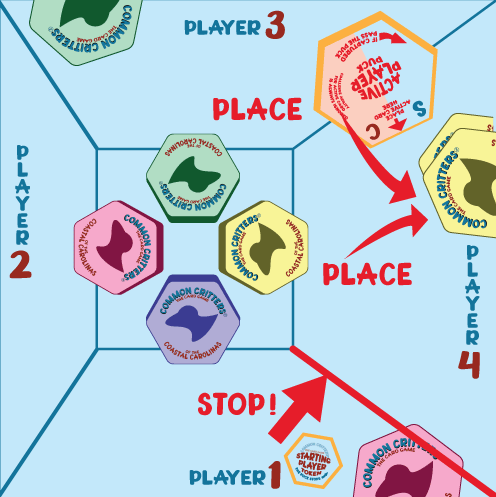

step-by-step
instructions & rules
There are many different ways to play common critters™.
Before you get started, here is a breakdown of the critter card layout.
The 48 critter cards are divided into four categories of 12 cards each based on color:
card categories

card breakdown
Each critter card has two distinct sides: a profile side and a face side.
The profile side includes the game logo and ecoregion, and a profile image (outline or silhouette) of this particular critter.
The face side is divided into a number of sections, each including a variety of critter information relevant to the game.
face side
profile side


Below you will find detailed step-by-step instructions and rules for a variety of ways to play common critters™.
game variations
Click on game title for step-by-step instructions
©
©
©
©
number of players: 2, 3, or 6 (more with multiple ecoregions)
recommended age groups: 4th - 8th Grade
critter capture
©
object
The object of critter capture is to collect more card points than your opponents by correctly selecting critter cards with a higher or equal commonness or size value, OR a beneficial counteractive challenge ability (capture/block).
setup
Separate the critter cards by color and shuffle them into four stacks or decks,
each of the same color.
Place the four decks in a circle at the center
of the playing area with the profile side up.
Choose the first starting player for the first round and place both the active player puck and the starting player token in front of them.


step 1
The starting player is the first active player of the round and draws the top card from any of the critter card decks.
BEFORE flipping or looking at the card, the active player chooses commonness or size, announcing their decision to the other players.
Player 1 has chosen a fish card and announced "size".
step 2
Player 1 now flips the active card over to the face side and places the card in front of them on top of the active player puck with the chosen commonness or size edge facing towards the challenge player (to their left).
The chosen card has a size vale of 8.
(Remember that the challenge ability of the active card is always ignored.)


step 3
Player 2 is now the first challenge player and draws a card (now the challenge card) from the top of any of the critter card decks.
Player 2 has drawn a mammal card.
(Note that the challenge player does not announce commonness or size.)
step 4
Player 2 flips the challenge card and places it next to the active card with the challenge abilityfacing toward the active card.
Players check to see if there is match between the color of the challenge ability on the challenge card with the base color of the active card.
In this case the challenge ability for the mammal card played by player 2 is block other and does not take effect because the active card is a fish.

B. capture - The challenge player takes the active card and places it into their critter corral FACE DOWN. The challenge player & card become the new active player & card, and play resumes at step 7.
C. block - The challenge player takes their challenge card and places it into their critter corral FACE DOWN. The active player & card remains the active player & card, the next player to the left is now the challenge player, and play resumes at step 7.
challenge ability outcomes:
A. trapped by - The active player takes the challenge card and places it in their critter corral FACE DOWN. (Each player places cards they have won next to them on the table in a small space. Just for pony kicks, let's call that space their critter corral! The active player & card remain the active player & card.

step 5
Since the challenge color did not match, Player 2 turns the challenge card so that the size value is pointing towards the size value of the active card on the puck.
Players compare values.
value comparison outcomes:
A. If the value of the challenge card is higher than the active card, the challenge player takes the active card and places it in their critter corral FACE DOWN and play resumes at step 7.
B. If the value is lower than the active card, the active player takes the challenge card and places it in their critter corral FACE DOWN and play resumes at step 7.
C. If the values are the same, place the active card underneath the challenge card. The challenge player/card becomes the new active player/card and chooses commonness or size. Any cards underneath the active card are taken with the active card. Play resumes at step 7.
step 6
Since the size value of Player 2's mammal card (3) is lower than the size value of Player 1's fish card (8), Player 1 captures the mammal card into their corral.
Player 1 remains the active player,
Player 1's mammal card remains the
active card on the puck.
Player 1 points the size edge of the
active card at Player 3.


step 7
It is now player 3's turn to draw and flip a card. Player 3 draws and flips an other card.
Before comparing size values, the challenge ability of the challenge card is checked for a color match.
Since the challenge ability color of the challenge card matches the color of the active card, the challenge ability takes effect.
step 8
The challenge ability of Player 3's other card is capture fish, so Player 3 captures Player 1's fish card into their corral.
Player 3 is now the active player and takes the active player puck from Player 1.
Player 3 places their other card onto the active player puck and turns it so the size edge is facing towards Player 4.
(Note that the starting player token remains in front of Player 1.)


step 9
It is now Player 4's turn to draw a challenge card. Player 4 draws an other card, then flips and places the card with the challenge ability edge facing towards Player 3.
Players check to see if there is match between the color of the challenge abiity on the challenge card with the base color of the active card.
step 10
In this case the challenge ability for
the other card played by player 4 is trapped by bird and does
not take effect because the
active card is an other.
Player 4 turns their challenge card so the size edge is facing towards Player 3's acitve card and players compare values.
The size value of Player 4's card is 8.


step 11
Since the size value of Player 4's other card is higher, Player 4 wins the challenge and places Player 3's captured other card into their critter corral.
Also, since Player 4 is the last player to play a card in this round, Player 4 places their own other card into their critter corral as well.
This concludes the first round. Players 1 and 3 have each captured 1 critter, Player 2 has captured 0 critters, and Player 4 has captured 2 critters.
subsequent rounds
The round has concluded once every player has selected and played a single critter card. The player to the left of the previous starting player (Player 2) becomes the new starting player and places both the starting player token and the active player puck in front of them.
Play resumes at step one with round 2. Player 2 now draws any card without revealing, announces commonness or size, and places the card on the puck with the chosen edge facing towards Player 3.
Play continues until all cards have been selected and played.
determining the winner
When all the cards have been selected and played (16 rounds for 3 players, 12 rounds for 4 players, and 8 rounds for 6 players) the game ends. Without looking at the face side of the cards in their critter corral, the player with the least number of cards (ties are won by the player who went last) chooses commonness or size. Each player then adds and totals the chosen commonness or size values for all of their cards.The player with the most points is the winner.
critter challenge
©
arriving february 1st
critter memory game
©
arriving february 1st
arriving february 1st
